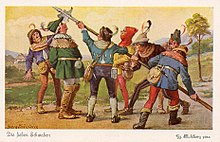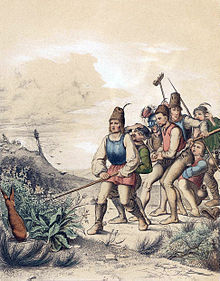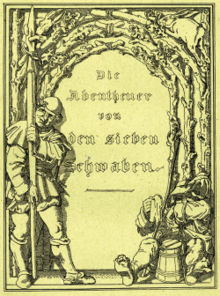The Seven Swabians
The Seven Swabians are a Schwank , which is about the adventures of seven Swabians portrayed as stupid . The climax is the fight with a monster that turns out to be a hare (international narrative type AaTh or ATU 1231). In the children's and household tales of the Brothers Grimm , Dummenschwank is in place 119 (KHM 119; ATU 1321C, 1231, 1297 *) after a version from Hans Wilhelm Kirchhof's Wendunmuth ( Von nine Swabians a histori ) and a sheet later published by Johannes Bolte ( Two leaflets from the seven Swabians in Zeitschrift des Verein für Volkskunde 4, 1894). The adventures of the seven Swabians became particularly well-known through Ludwig Aurbacher's Volksbüchlein (from 1827). The seven protagonists represent seven character types. In Ludwig Bechstein's German Fairy Tale Book , The Fairy Tale of the Seven Swabians is from 1845 as No. 3, from 1853 No. 2 (ATU 1321C, 1290, 1231).
Plot in Kirchhofs Wendunmuth (from 1563) and Grimms Märchen (from 1819)

Seven Swabians are looking for adventure with a long skewer. On the way (in the hay month) an insect hums in the twilight, when the foremost man, Mr. Schulz, imagines a war drum. He escapes over a fence, steps on a rake, the handle hits him in the face, and surrenders, the others too. A hare sleeps on a fallow field in the sun. They discuss what to do and seven of them go on the spit at the supposed dragon until Mr. Schulz speaks so loudly out of fear that the rabbit runs away. On the Moselle they shout over the water how to get over and are not understood. Mr. Schulz misinterprets the answer “what? wat! ", wades in and sinks. His hat swims over it, a frog croaks "wat, wat, wat", and the others follow suit and drown too.
language

Dialogues especially ridicule the dragon fight . The seven Swabians, called “der Herr Schulz”, “der Jackli”, “der Marli”, “der Jergli”, “der Michal”, “der Hans” and “der Veitli” fear that the rabbit would eat them “with skin and hair ”(cf. KHM 5 , 23 , 134 ) and encourage each other. “Mr Schulz took heart” (cf. KHM 60 , 86 , 127 , 133 ) “and spoke gravely
- «So go heartily into the argument,
- this is how one recognizes brave people. "
The Brothers Grimm knew the sentence “freshly dared is half won” (cf. KHM 114 ) from the Churmainzer war song in Des Knaben Wunderhorn and Lever's Treasure Chest , Jacob Grimm uses it in German Grammar as an example of past participle “in formulas and sayings”. The linguistic joke with the frog croak already existed in KHM 7 Der gute Handel , jumping into the water in KHM 61 Das Bürle .
origin

Grimm's comment mentions Kirchhof's Wendunmuth as “1, St. 274” as a source , as well as a “Meistergesang” and a flying sheet “from Nuremberg at Fr. Campe”. You also quote a “story with the rabbit” in Eyering's “Proverbs 2, 227” and other passages. Their processing clearly adheres to Kirchhof's text, modernizing it in terms of language. The fact that the foremost “had a secret one deleted” out of fright, they softened linguistically, that his “hurlehau better then a thousand gotthelf” was omitted. They took over the rhyming hunting dialogue from the aforementioned "flying leaf", it was published in 1894 after Johannes Bolte in the magazine of the Verein für Volkskunde 4 ( two leaflets from the seven Swabians ). Place names were probably omitted for reasons of the type of text, with the exception of the Moselle , "a musky, calm and deep water". Kirchhof is the reason for the departure of the nine Swabians as a pilgrimage to the Holy Rock in Trier and Aachen. It ends soothingly: “It is not so good for Swabia…” Hans Sachs ' master song No. 231 The nine Swabians from 1545 appeared in Arnims Des Knaben Wunderhorn as No. 445 The Swabian Round Table and tells the second adventure with one instead of a rabbit Frog, but is not visible in Grimm's editing. According to Hans-Jörg Uther , Kirchhof apparently knew this or Der Schwab mit dem Rechen , also in 1545, no. 179. The later editions in Grimm do not seem to differ. They then took over a similar prank from Kirchhof in KHM 174 The Owl .
Cf. also Grimms KHM 70 The three lucky children or the song A hunter walked along the pond .
Aurbacher
In Ludwig Aurbacher's Volksbüchlein (from 1827) the adventures of the seven Swabians are much longer.
Bechstein
Ludwig Bechstein's fairy tale of the seven Swabians is longer than Grimm's text. In addition to Grimm's version, it is based on Ludwig Aurbacher's Volksbüchlein in the 2nd edition from 1835.
Material history

In 2007 the historian Klaus Graf suspected in the encyclopedia of fairy tales that a mention of the cowardice of the Swabians, who are like rabbits, in a Latin victory song for the Battle of Giengen is based on an allusion to the subject matter of the Seven Swabians. Accordingly, the origin of the story could be found in national ridicule at the tribal border between Bavaria and Swabia. The oldest complete version offers a master song by Hans Sachs (1494–1576) in 1545 - albeit with the Nine Swabians . One of the sayings collected by Johannes Agricola († 1566) is: He is afraid for himself . To this end, wrote Eucharius Eyring († 1597) a rhymed statement in which the Sieben Schwaben occur (published in the three volumes of Proverbiorum Copia, Eisleben 1601-1604):
“In Mertzn one siben man traveled , who
only threw a pork spit,
In which time the rabbits run blindly
across the field quickly, called
Von Schwaben Ragen Ohrlin.
When they went across the country,
Lieff in a hare without much over
the cross field, who are
accustomed to take such a bogus,
When a hare first come across
soon said, who
throws the spit, Then everyone steps up to the work,
stretched present the spear to the hare,
fear that he would eat them.
And when they stood on the spit,
The one behind what kün, left himself,
He must eat the six in front of everyone,
Before he also measured it,
And spoke to the rabbit bravely,
Gangk ran, Ragen Ohrlin, gangk ran,
Welchs the fordren angry thett,
who wriggled around and to in the red,
yes he was standing forn as ech,
you would not speak so, Gangk ran, Ragen Ohrlin, gangk ran.
I have to turn to the first,
and when he breaks me down, then
I would give me all the escape.
And stand by me when I vanquished,
Just like the hare with its young ones ,
Before whom we
want to be scared to death with spot allampt. "
The early modern mockery of the Swabians liked to pick up on the story circulated in printed Schwankbuch. Printed illustrated leaflets from the 17th century quoted the Swabian dialect. Sebastian Sailer dedicated his own dialect poem to the topic, the forerunner of a whole series of folk plays on the subject.
The Sieben Schwaben became particularly popular because of Ludwig Aurbacher's frequently reprinted Volksbüchlein , in which literary fluctuations from the early modern period were processed into a series of episodes. Aurbacher provided some episodes with a regional reference to his homeland, from him the Seven Swabians received their names in the 2nd volume of the Volksbüchlein from 1829 (the names are immortalized on the house where he was born):
Even if some of them are assigned a national team, they are more representative of the characteristics that are ascribed to the inhabitants of the respective region.
Leaning literature
It is impossible to overlook the literary and extra-literary testimonials of the material, which was essentially shaped by Aurbacher. There are countless editions and adaptations of the story, as well as books that lean on the popularity of the subject. So published Theodor Heuss a literary anthology of seven modern authors under this title.
In 1887 Karl Millöcker created an operetta The Seven Swabians .
In 1992 Rolf Gozell implemented the material in the children's radio play Hans Eierkuchen .
Siegfried Stadler ironically provided a Marxist interpretation.
The house in which Joseph Haydn composed Austrian imperial hymns was then called “To the Seven Swabians”.
Cult of the Seven Swabians
Aurbacher's birthplace, Türkheim, has protected the term of the Seven Swabians. The local history museum is called the Sieben-Schwaben-Museum , and Aurbacher's birthplace became the Siebenschwabenhaus . The carnival association is called Sieben Schwaben Türkheim eV
In Swabia

It is noteworthy that, similar to local scorn, the original ridicule of the Swabians is taken up by them and positively re-evaluated. The mock figures became Swabian identification symbols.
- Some local companies have integrated the Seven Swabians into their company names.
- From 1950 to 1979 the magazine of the Swabian homeland care appeared in Kempten (Allgäu) under the title The Seven Swabians .
- The tourism working group of the cities of Stuttgart, Esslingen, Fellbach, Ludwigsburg, Reutlingen, Sindelfingen and Tübingen gave itself the name 7 Schwaben in the 1980s .
- In Augsburg one is seven-Schwaben Award in several categories awarded.
- In Bolheim , part of the landscape protection area there is officially called the rabbit hole after an incident by the Seven Swabians . Seven trees growing in a row in an otherwise woodless place are still today a reminder of the alleged encounter between the Swabians and the hare there.
- One of the Seven Swabians is nicknamed Seehas at Aurbacher . This is the namesake of the sea hare festival in Friedrichshafen on Lake Constance ; a train on Lake Constance is also called Seehas .
- The Stuttgart Ultimate Frisbee team is called 7 Swabians .
- In the Ulm / Neu-Ulm area there is the Seven Swabian Carnival Association, which is made up of seven carnival associations .
- In Kornwestheim there is the theater Die 7 Schwaben, which regularly gives performances from the genre of amusingly entertaining folk theater in its own theater in the casino .
- At the Tripsdrill amusement park , the head-to-head roller coaster will open in 2020 , which will be thematized around the Seven Swabians.
At many festivities the Sieben-Schwaben material is taken up and presented as a "scenic" group at the Rutenfest Ravensburg , at the Fisherman's Day in Memmingen or at the fool's jumps of the Swabian-Alemannic Carnival .
Outside of Swabia
- There are numerous inns with the name Zu den Sieben Schwaben or individual characters such as Restaurant Blitzschwab - also outside of Swabia, for example in Prague .
- Restaurants call meat dishes Sieben Schwaben .
- In the Dresden district of Neugruna (today Blasewitz) there is a seven-Swabian school .
- In Weißenbach am Lech , the "Seven Swabians" lead the traditional village parade during carnival.
- The sculpture group shown below by the sculptor Hans-Georg Damm is located on Fehrbelliner Platz in Berlin.
Pictorial representations and exhibitions
- The Zizenhausen terracottas represent u. a. The 7 Swabians .
- One of the many representations in public space since 1978 has been a seven-Swabian sculpture on Fehrbelliner Platz in Berlin-Wilmersdorf on the median of Hohenzollerndamm .
- From March 17th to October 6th 2013 the Swabian Folklore Museum Oberschönenfeld showed an exhibition about the Seven Swabians.
See also
literature
- Miriam Régerat: Swabian images through the ages. The moving reception of the motif of the “Seven Swabians”. In: The Swabians between myth and brand. Landesmuseum Württemberg and Chr. Belser Society for Publishing Business , Stuttgart 2016, ISBN 978-3-7630-2757-6 , pp. 312-315.
- Heinz Rölleke (Ed.): Grimm's fairy tales and their sources. The literary models of the Grimm fairy tales are presented synoptically and commented on. (= Literary Studies Series. Volume 35). 2., verb. Edition. Wissenschaftlicher Verlag, Trier 2004, ISBN 3-88476-717-8 , pp. 122-131, 559-560.
Footnotes
- ↑ Lothar Bluhm and Heinz Rölleke: “Popular speeches that I always listen to”. Fairy tale - proverb - saying. On the folk-poetic design of children's and house fairy tales by the Brothers Grimm. New edition. S. Hirzel Verlag, Stuttgart / Leipzig 1997, ISBN 3-7776-0733-9 , p. 130.
- ↑ Heinz Rölleke (Ed.): Grimm's fairy tales and their sources. The literary models of Grimm's fairy tales are synoptically presented and commented on (= literature series literary studies. Volume 35). 2nd Edition. Wissenschaftlicher Verlag Trier, Trier 2004, ISBN 3-88476-717-8 , pp. 122-130, 559-560.
- ↑ Hans-Jörg Uther: Handbook on the children's and house tales of the Brothers Grimm. de Gruyter, Berlin 2008, ISBN 978-3-11-019441-8 , p. 263.
- ^ Hans-Jörg Uther (Ed.): Ludwig Bechstein. Storybook. After the edition of 1857, text-critically revised and indexed. Diederichs, Munich 1997, ISBN 3-424-01372-2 , p. 381.
- ^ Klaus Graf: Seven Swabians. In: Encyclopedia of Fairy Tales. 12, 2007, Sp. 649-654 (online) . Expanded in the essay: Klaus Graf: About the origin of the Seven Swabians from the national ridicule. In: Dorothee Pesch, Elisabeth Plößl, Beate Spiegel (eds.): The seven Swabians. Stereotypes, Ludwig Aurbacher and the popularization of a Schwank. Booklet accompanying the exhibition "The Seven Swabians - From Schwank to Brand" in the Swabian Folklore Museum Oberschönenfeld from March 17th to October 6th 2013 (= series of the museums of the Swabian district. Volume 48). Swabian Folklore Museum, Oberschönenfeld 2013, pp. 15–17, 20–23, 27–31. doi: 10.5281 / zenodo.32427
- ^ Siegfried Stadler: Marx's fairy tales. In: Die Horen. Volume 1/52, No. 225, 2007, ISSN 0018-4942 , pp. 211-216.
- ↑ Siebenschwabenhaus.de
- ↑ seven-schwaben.de ( Memento of the original from January 25, 2013 in the Internet Archive ) Info: The archive link was inserted automatically and has not yet been checked. Please check the original and archive link according to the instructions and then remove this notice.
- ↑ kurierverlag.de, article from June 8th, 2012
- ↑ Hermann Scholz: When ridicule becomes a brand. ( Memento of April 9, 2013 in the Internet Archive ) (video no longer available)
- ↑ schwaebisches-volkskundemuseum.de






